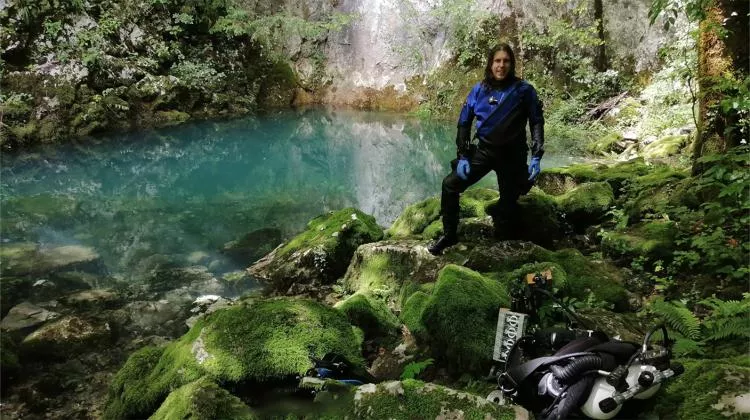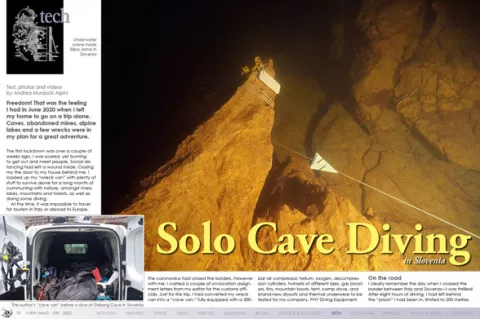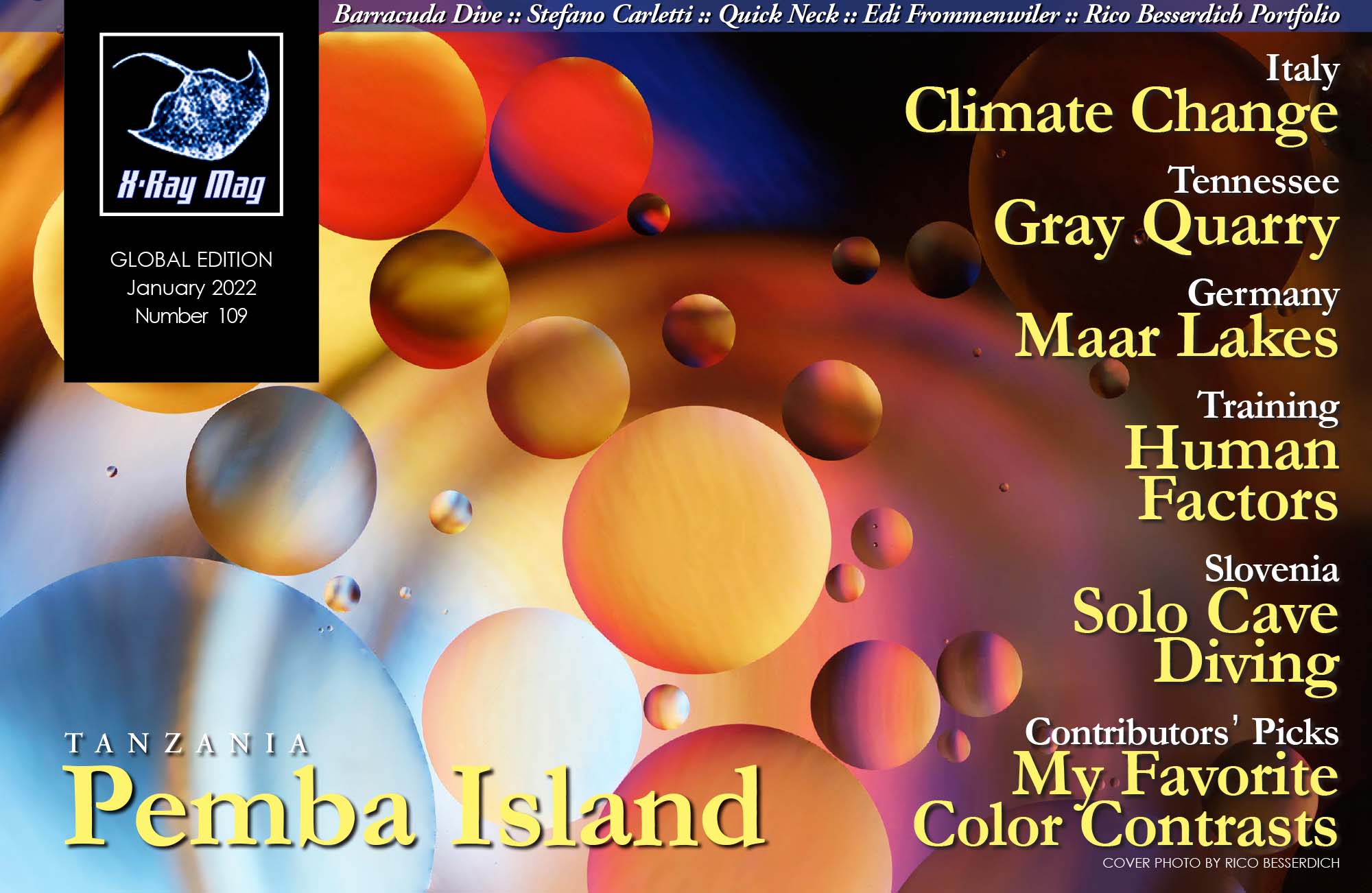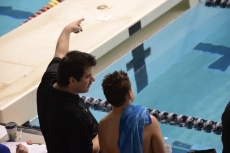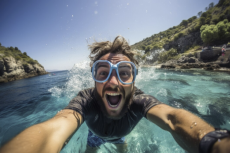Freedom! That was the feeling I had in June 2020 when I left my home to go on a trip alone. Caves, abandoned mines, alpine lakes and a few wrecks were in my plan for a great adventure.
Contributed by
The first lockdown was over a couple of weeks ago. I was scared, yet burning to get out and meet people. Social distancing had left a wound inside. Closing my the door to my house behind me, I loaded up my “wreck van” with plenty of stuff to survive alone for a long month of communing with nature, amongst rivers, lakes, mountains and forests, as well as doing some diving.
At the time, it was impossible to travel for tourism in Italy or abroad to Europe. The coronavirus had closed the borders. However, with me, I carried a couple of on-location assignment letters from my editor for the customs officials. Just for this trip, I had converted my wreck van into a “cave van,” fully equipped with a 300-bar air compressor, helium, oxygen, decompression cylinders, twinsets of different sizes, gas boosters, fins, mountain boots, tent, camp stove, and brand-new drysuits and thermal underwear to be tested for my company, PHY Diving Equipment.
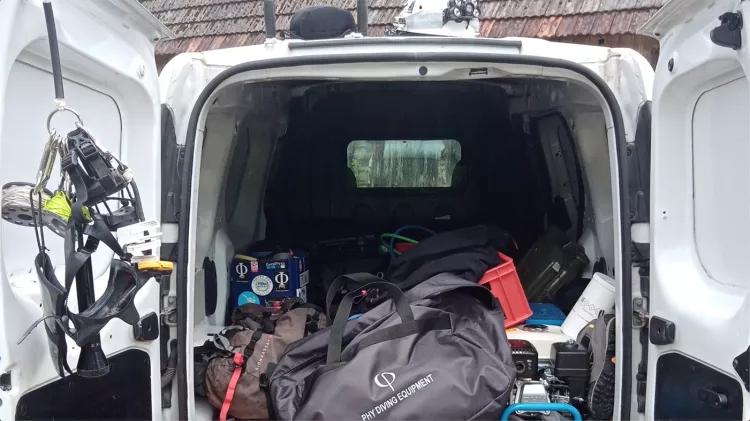
On the road
I clearly remember the day when I crossed the border between Italy and Slovenia—I was thrilled! After eight hours of driving, I had left behind the “prison” I had been in, limited to 200 metres around my house due to Covid-19 restrictions, to have the sensation of freedom, walking into wild nature, on my own. The mental switch was awesome and unexpected. I made just one phone call abroad, followed by an incredible conversation in Russian with the first guy I met in a small rural village in Slovenia. He had emigrated some years ago and now welcomed travellers at his farmstead.
Anyway, once I arrived on site, I was not very welcomed by the weather: heavy rain. After the storm, I went out walking and filmed my surroundings with my smartphone. I decided to record the whole trip. Unfortunately, the rain came back again and never left me for the entire length of my trip (almost a month).
My tour would take me through Slovenia, Garda Lake in Italy, the Austrian end of the South Tyrol Alps, Tuscany’s caves and finally, the central part of Italy—the Appennini mountain range and its peaks. I had planned to visit two mines, but heavy rains put a halt to my plans.
Challenging conditions
Except for Slovenia, where I slept in a traditional bed, I spent the rest of the trip in my tent. Cold weather and storms were my buddies during the month-long journey. I did see a ray of sunlight, just for a few hours one day, but I never got the chance to dry my equipment, and I reverted to warming myself inside the van. Each night, I could only sleep for a few hours due to the noise of the wind and the intense rainfall. Day by day, I grew more and more tired, and more and more feeble. One day, while I was in South Tyrol, descending a mountain, three weeks after I had left home, I decided to end my trip and retreat, back to the safety of home.
The goal of my trip was to tell dive adventures from a surface point of view, in which the water is only a part of the context and is not the objective. I filmed a mini-series made up of three chapters. Each one brings you inside the scene. The first episode of the trip can be found here: youtube.com/watch?v=hq2eabK39ZA.
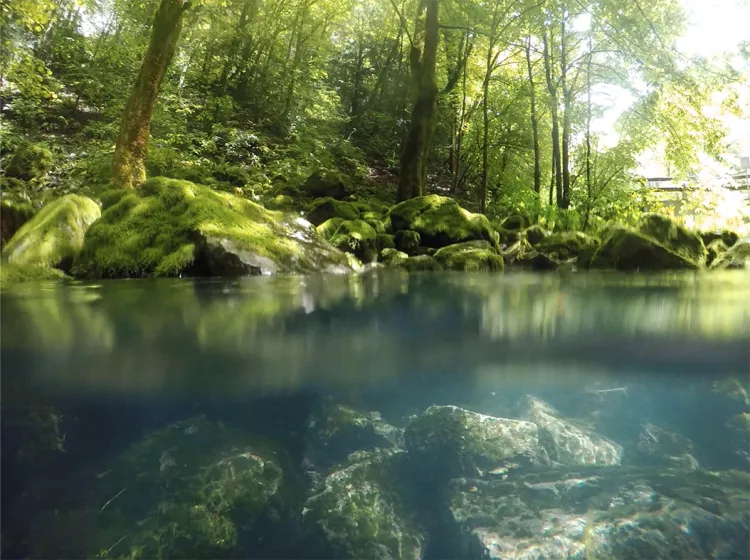
Diving
The first day of cave diving in Slovenia was very tricky and full of adventure. I had no idea how the second day would be!
Around 6 a.m., I left my lodging after a good breakfast: cereal, dark chocolate with black coffee, dried fruit and tasty Italian parmesan cheese. Outside my window, I could not see anything. What was falling from the sky was not just a simple rain, it seemed like a deluge. My plan for the day? Burnt up in a few seconds.
Most of the dry caves within a few hundred kilometres were closed, so I decided to check the forecast, conditions and water levels in the caves close to the Croatian border. I had to drive around for four hours to get there and personally find out if diving was allowed or not. Mind you, I did not forget that I was here, diving alone.
I set my wheels to the road, as local conditions at the destination seemed to be quite good. I had checked the weather on my laptop and decided to take the risk. If I was lucky, I could dive; if not, I had to drive back.
I drove through the Slovenian forests, meeting no one. Less than an hour away from my destination, I came across an abandoned farming village; it was completely empty.
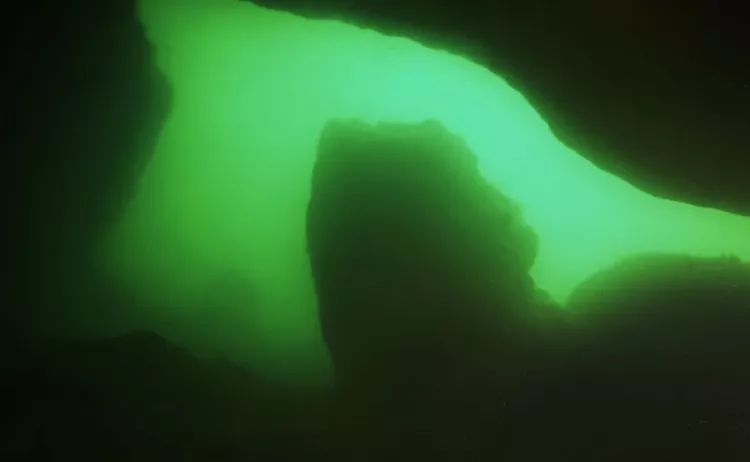
Bilpa Jama
The dive inside the cave of Bilpa Jama was breathtaking. Afterwards, I sat at the water’s edge inside the cave, preparing hot soup to warm myself. I had enjoyed a stunning solo dive, and now I was cold. I just wanted to get a taste of the timeless feeling within this place. While I was stirring my cup of soup with a spoon, I heard a distant voice calling me; It was a policewoman asking me to stop eating and come quickly to her.
She looked over my passport, documents and permits. A few minutes later, a huge national army truck reached us. The soldier who came out of the truck to meet us was not of normal build, he was a walking mountain, dressed in army fatigues. One can just imagine now, how I was feeling in that moment!
Well, in the end, everything went really well, and I got a story to tell the grandkids one day. Once the passport control was over and they had checked that I had not crossed the border from Croatia to Slovenia illegally (the customs office was only a few hundred metres from us), I had the chance to get back to my soup, which had turned cold. I warmed it up again and spent half an hour looking at the beauty of the forest surrounding me, as I sat on a slick stone covered in moss and lichens. Then, I turned the key in the cave van again and headed out, playing a new playlist on the way back to my lodging.
Four hours later, I reached my country lodge. I was really tired and drained of energy, but I still had to refill tanks and plan the next day of diving. Once I finished all that stuff, I checked the forecast again. Unfortunately, the weather was getting bad again, so I decided not to dive and just take a surface interval. Tomorrow, I would drive, scout out the location, and gather information and GPS coordinates of the caves there. My plans for tomorrow had turned into a sketching and surveying day.
I drove and walked for hours and hours, up and down forests and lonely roads in search of the caves where I might return to dive in the winter or next year. During the last survey of the day, I ran into a talented young man playing a traditional concertina, what a lovely way to end my day of hard work!
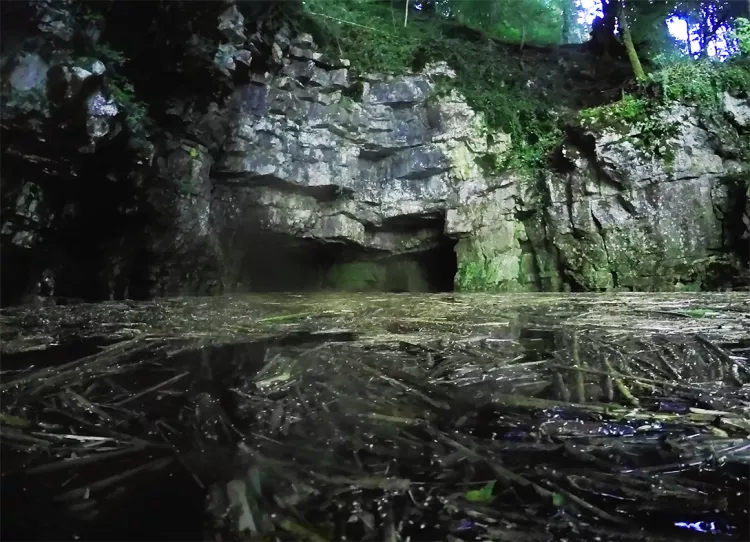
Suha Dolca
On the way home, I decided to take a last glance at the cave of Suha Dolca, my favourite one. This was the third consecutive day in which I had returned to this very spot. Observing it day by day, I had tried to figure out the best time to dive this cave. Up until now, it had been inaccessible due to strong current. But I wanted to dive here before leaving Slovenia.
Tired and driving as slow as a snail, I parked my van beside my lodging. I had had no lunch and was really hungry. A simple dinner was quickly prepared: dried fruit and a hot cup of noodle soup.
This trip, which I had dubbed “No Direction Home,” was now at its peak, and I was getting in touch with the feeling of wandering. I was alone in wild countryside. Internet connection to do historical research and check the weather forecast was the only technology I used. On the other hand, I was living in a simple way: walking, diving, writing and filming my experience with a mobile phone. (See: youtube.com/watch?v=A5Gx0zRJnLU)
The rains continued to be more challenging than expected. I had to pause my plans for two days, not just one, as I had hoped. Following my surveys, I started preparing my video equipment for the next day and saving images and video footage onto my laptop’s hard disk.
I had too many ideas, with no one clear direction to focus on, and too many cave diagrams and GPS points to reorganise, so a day off from diving was compulsory.
I just went out for a few hours to check the conditions at the cave of Suha Dolca. Today, it seemed the current was getting more stable, and the general water conditions were also getting better. I had to be patient and wait one or two more days; eventually, the current would definitely stop. During this time, I tried to figure out a solution, but the water always showed me the door. She told me to wait and go back to where I came from. Footstep after footstep, I walked the path again.
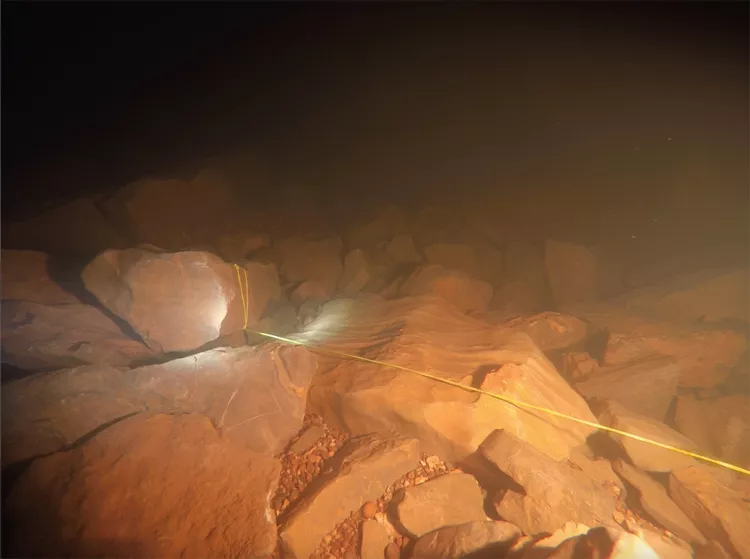
Chapter Three
The third chapter in my video documentary of my solo cave diving trip in Slovenia is the one I prefer, recalling the indecision I experienced at the time: Do I stay, or do I go? Solo trips are intricately linked to one’s life decisions.
The last day I was in Slovenia, I left my lodging and asked another farmer, located close to a different cave, if I could sleep inside the barn and dive the river hole the following day. I was in the same place where I dived the first day. He told me I could not stay in the barn due to the high risk of bears, which lived in the surrounding area. I jumped in my van again and drove to the lake next to the cave of Suha Dolca. I descended the path several times, carrying and transporting, piece by piece, all my dive gear.
In the late afternoon, I decided to give myself a chance to fulfil my aspirations of diving this cave. I had no other choice. Once I was inside the cave, however, it was unbelievable! I had a very nice dive, even though I was really tired and had again broken the light arms and camera housing of my rig. I resurfaced after the dive into a reed lake, which made me feel like a beaver.
After the tricky, yet stunning dive, I left Slovenia that same night, with conflicting feelings. Bears, awesome forests and rural areas were now behind my shoulders.
Inside the cave van, a new disc was playing. I needed to shake off recent endeavours and look forward to my new goals: the wrecks of Garda Lake and South Tyrol’s stunning lakes in Italy, and finally, Austria—the country of green and wide grazing lands, where I wanted to dive surrounded by the amazing scenery of the beautiful Alps. (See: youtube.com/watch?v=S-_VE_dapzw)
At 9.30 p.m., I crossed the border again: Italy was now straight ahead. ■
Based in Italy, author Andrea Murdock Alpini is a technical diving instructor for TDI, CMAS and PSAI. Diving since 1997, he is a professional diver focused on advanced trimix deep diving, log dives with open circuit, decompression studies, and research on wrecks, mines and caves. Diving uncommon spots and arranging dive expeditions, he shoots footage of wrecks and writes presentations for conferences and articles for dive publications and websites such as ScubaPortal, Relitti in Liguria, Nautica Report, ScubaZone, Ocean4Future, InDepth and X-Ray Mag. He is also a member of the Historical Diving Society Italy (HDSI), and holds a master’s degree in architecture and an MBA in economics of arts. He is the founder of PHY Diving Equipment (phidiving.com), which specialises in undergarments for diving, as well as drysuits, hoods and tools for cave and wreck diving. Among other wrecks, he has dived the Scapa Flow wrecks heritage, Malin Head’s wrecks and the HMHS Britannic (-118m), Fw58C (-110m), SS Nina (-115m), Motonave Viminale (-108m), SS Marsala (-105m), UJ-2208 (-108m) and the submarine U-455 (-119m)—always on an open circuit system. His first book (in Italian), Deep Blue, about scuba diving exploration was released in January 2020 (see amazon.it). For more information on courses, expeditions and dived wrecks, please visit: wreckdiving.it.

